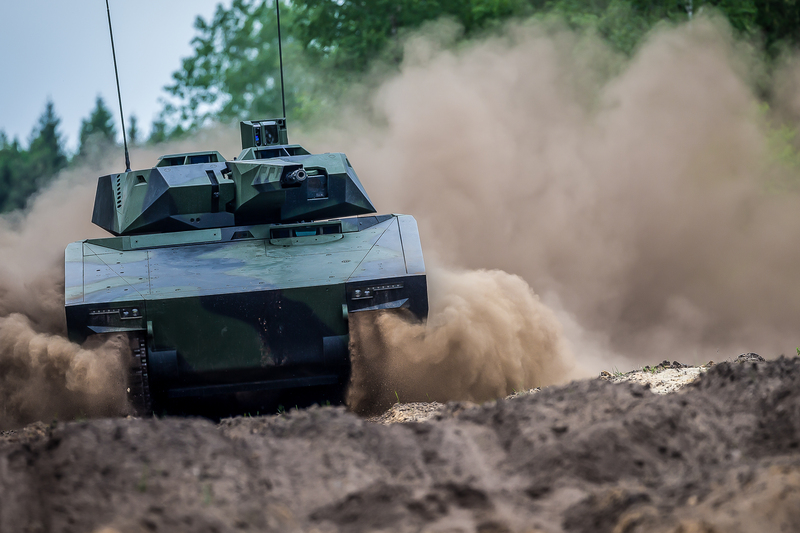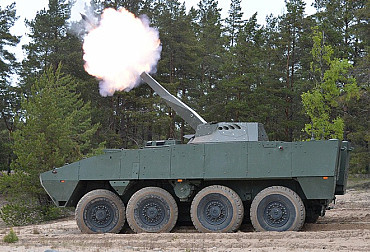The Lynx KF41 is armed for the future
The Lynx KF41 Infantry Fighting Vehicle (IFV) from Rheinmetall is a key contender for the Czech Republic’s IFV modernisation programme. The revitalisation of Czech armoured capabilities with 210 new IFVs sees defence decision makers considering battlefield concerns not only of the present days, but also of decades to come. With its future-proof armaments, the Lynx stands ready to survive and dominate in present and future conflicts.

Picture: LYNX KF41 | Rheinmetall
Lance Turret, Superior Firepower and Lethality
The turret system is the single most important battlefield capability for any IFV. Decades of experience in producing turrets has come together with Rheinmetall’s expertise in fire control systems, medium- and large-calibre weapons, and various wheeled and tracked armoured vehicles, to make the Lynx’s Lance 2.0 turret system a uniquely modular and powerful asset.
The Lance 2.0 turret accurately performs in any mission and on various types of platforms. The fully digitized and electrified turret drive system combined with a high performance digital fire control system ensure long-range precision targeting. Both the gunner and the commander are using the SEOSS (Stabilised Electro-Optical Sighting System) for effective surveillance, targeting and engagement at day and night under all visual conditions.
HDF.jpg)
Picture: LANCE 2.0 Turret | Rheinmetall
The Lance 2.0 turret can be customized with countless variation possibilities. Facilitating generic vehicle architecture (GVA) makes the turret almost as flexible as the Lynx KF41 vehicle itself. As well as systems - e.g. jammers, sensors, UAVs - additionally integrated to the turret, also the use of different protection packages for the crew compartment and essential systems is possible depending on the planned mission. To ensure best protection of the crew and highest combat strength of the system, the commander of the task force has the opportunity to swap protection packages also in the theatre prior to mission only supported by field service personnel and equipment.
 Picture: LYNX KF41 firing | Rheinmetall
Picture: LYNX KF41 firing | Rheinmetall
“In the last five decades Rheinmetall has supplied more than 6,000 turrets, complete with advanced technologies, to customers all over the world,” says Oliver Mittelsdorf, Senior Vice President Sales at Rheinmetall Defence. “We have also delivered more than 10,000 fire control systems, as well as and medium- and large-calibre weapons. This experience gives us a deep insight into what armed forces expect from armoured vehicle turret systems. The Lance 2.0 turret, with its unique blend of flexibility and lethality, is the perfect weapon system for the Lynx KF41.”
MK30-2/ABM cannon - state of the art armament
The Lynx’s field-proven main armament, integrated in the Lance 2.0 turret, is already in service in vehicle platforms of allied countries such as Germany, Australia and Spain. The gas-operated MK30-2/ABM automatic cannon can fire single rounds as well as bursts of 200 rounds a minute. Technically the MK30-2/ABM is capable to fire up to 600 rounds per minute, but for the application in an IFV, the rate of fire is limited, also for the sake of the lifetime of the weapon. Though the MK30-2/ABM makes no compromises, neither in lethality, nor in endurance.
Operational flexibility is ensured with a “next round, new type” ammunition feed philosophy – the weapon can fire two different ammunition types to allow selectively lethal effects. The optimum combination of high firing rate and modern airburst ammunition technology makes the MK30-2/ABM an uncompromising weapon system and sets new standards in terms of durability, reliability, technical maturity and precision. It delivers high combat effectiveness against ground and aerial targets up to a distance of 3,000 metres. In addition to the main armament, the Lynx’s IFV configuration features a 7.62-mm co-axial machine gun (MG). The commander and the gunner are able to control and fire the co-axial MG via the same interface as the primary weapon, providing fast and flowing weapons switching depending on the specific requirements of the engagement.
Killer-Killer capability
With the optional Main Sensor Slaved Armament (MSSA) the Lynx KF41 gains additional advantage in close-combat environments. The Line of Fire (LoF) of this secondary weapon is able to follow the commander’s Line of Sight (LoS) and is stabilised in elevation and azimuth axes. The MSSA can be fitted with machine guns of different calibres or a 40-mm Grenade Machine Gun (GMG) to enable engagement of secondary targets independently of the primary weapon. The MSSA can also be fitted with a range of other less-than-lethal and non-lethal weapons.

Picture: SEOSS-2P configured as a Main Sensor Slaved Armament (MSSA) equipped with 7.62 mm x 51 machine gun | Rheinmetall
The MSSA facilitates the engagement of targets especially at high elevation in close range, such as Unmanned Aerial Vehicles (UAVs) and shooters on roof tops. If the commander operates his reconnaissance systems to assist the gunner in target acquisition, the Lynx fulfils “hunter-killer” functionality. But when the MSSA comes into play, the commander is able to individually engage targets with the secondary weapon while the gunner operates the main armament against other targets at the same time, the Lynx takes on doubly-powerful “killer-killer” capabilities.
Another optional weapon system is the Anti Tank Guided Missile (ATGM) launcher capable of firing Spike LR missiles. In most IFVs, vibration causes loaded ATGMs to deteriorate, meaning they have to be loaded just prior to firing. The Lynx allows greater preparedness through a vibration damper allowing ATGMs to be loaded further in advance. The flexible mission pod on the Lance 2.0 turret can be fitted with a variety of other subsystems for specific requirements, including an electronic warfare capability and non-line-of-sight strike loitering munitions. The crew can even launch a UAV from the vehicle to gain invaluable surveillance information for the crew and mission commanders.
Video: Rheinmetall presents its LYNX KF41 IFV / YouTube
“Whether stationary or on the move, the Lynx is a deadly threat for both static and moving targets, in any weather, any terrain, day or night,” says Oliver Mittelsdorf. “At the same time, its flexibility gives it a far wider capability spectrum than other IFVs in service today. The Czech Republic has the option of choosing a predator which is ready to defeat the possible threats of tomorrow.”





















